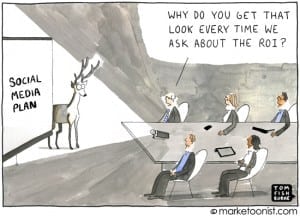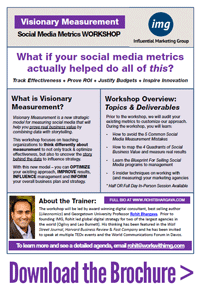We often use the word “visionary” to describe leaders or companies, but rarely in connection to metrics. If the typical communications strategy is dispersed via Powerpoint within a large organization, usually measurement is the last slide before the end.
We need to transform our relationship to measurement.

Nowhere is the fear of metrics more pronounced than when it comes to social media.
It doesn’t have to be this way. Changing it, though, requires a new understanding of why and how we can measure. That’s the simple idea behind this post – and a keynote talk I delivered earlier today at the Ragan PR Measurement Summit called “The Art of Visionary Measurement.”
Visionary Measurement is a new strategic model for measuring social media that will help you prove real business value by combining data with storytelling. It is not a new platform or a spreadsheet template. It isn’t based on a new technology. Instead, it is a new methodology for thinking about your metrics in terms of business value instead of solely on measuring effectiveness in selling something or influencing someone.
THE FOUR ELEMENTS OF BUSINESS VALUE
True business value goes beyond sales. It is a way to describe the impact of what you do based on four distinct elements – Sales, Efficiency, Innovation and Retention.
- Sales – Increase sales or customer loyalty.
- Efficiency – Create efficiency or save money.
- Innovation – Inspire innovation or motivate team.
- Retention – Drive employee retention or hiring.
These four elements describe nearly every possible type of value you might get from a social media program – but the real trick is that you need to be disciplined about selecting ONE of these to focus on. It is nearly impossible to accomplish every one of these with a single initiative.
The most common metrics mistake is measuring against the wrong objective.
When it comes to describing the business value, it also helps to think about measurement with the same audience lens that you might use for building a communications program. Every audience would not receive the exact same messages from your marketing – so why should measurement be any different?
THE VISIONARY MEASUREMENT MATRIX

The matrix describes four of these quadrants. The important thing to remember as you review them is that each one has a place and time where it may be useful. Ultimately, what the matrix illustrates is that measuring effectiveness is only the beginning of the potential uses for smarter strategic measurement.
Want To Put Visionary Measurement To Work For Your Brand?

- How to avoid the 5 Common Social Media Measurement Mistakes
- How to map the 4 Quadrants of Social Business Value and measure real results
- Learn the Blueprint For Selling Social Media programs to management
- 5 insider techniques on working with (and measuring) your marketing agencies
If the model seems interesting to you – or you have any suggestions or thoughts about what else you would change about how and why we measure, I’d love to hear from you. Leave me a comment here, email me at rohit [at] workwithimg [dot] com, or use my official (but not too formal) contact form to get in touch.







WE RECENTLY REMOVED COMMENTING - LEARN WHY HERE >